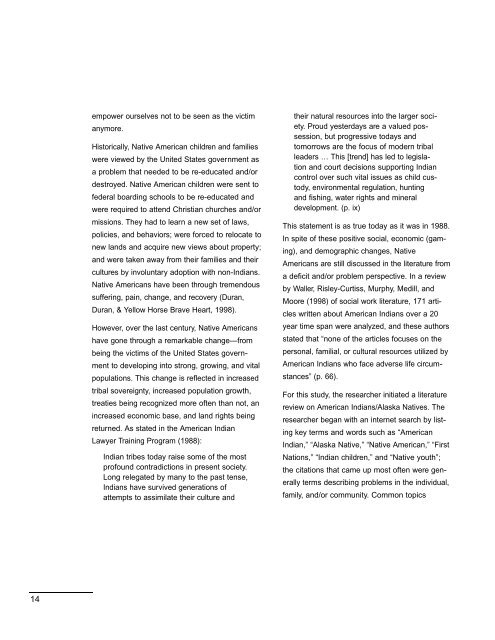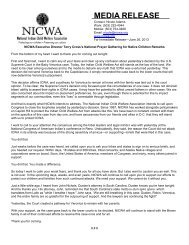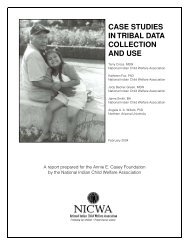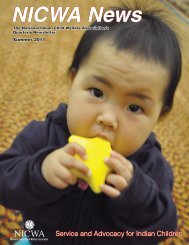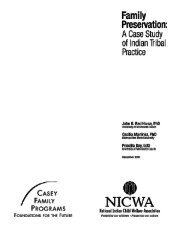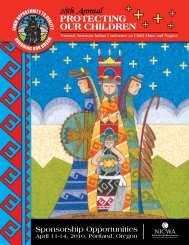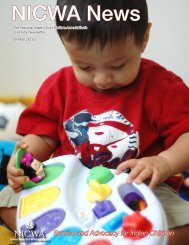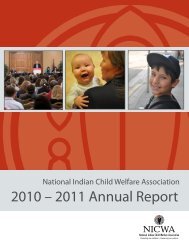Native American Children and Youth Well-Being Indicators
Native American Children and Youth Well-Being Indicators
Native American Children and Youth Well-Being Indicators
You also want an ePaper? Increase the reach of your titles
YUMPU automatically turns print PDFs into web optimized ePapers that Google loves.
empower ourselves not to be seen as the victimanymore.Historically, <strong>Native</strong> <strong>American</strong> children <strong>and</strong> familieswere viewed by the United States government asa problem that needed to be re-educated <strong>and</strong>/ordestroyed. <strong>Native</strong> <strong>American</strong> children were sent tofederal boarding schools to be re-educated <strong>and</strong>were required to attend Christian churches <strong>and</strong>/ormissions. They had to learn a new set of laws,policies, <strong>and</strong> behaviors; were forced to relocate tonew l<strong>and</strong>s <strong>and</strong> acquire new views about property;<strong>and</strong> were taken away from their families <strong>and</strong> theircultures by involuntary adoption with non-Indians.<strong>Native</strong> <strong>American</strong>s have been through tremendoussuffering, pain, change, <strong>and</strong> recovery (Duran,Duran, & Yellow Horse Brave Heart, 1998).However, over the last century, <strong>Native</strong> <strong>American</strong>shave gone through a remarkable change—frombeing the victims of the United States governmentto developing into strong, growing, <strong>and</strong> vitalpopulations. This change is reflected in increasedtribal sovereignty, increased population growth,treaties being recognized more often than not, anincreased economic base, <strong>and</strong> l<strong>and</strong> rights beingreturned. As stated in the <strong>American</strong> IndianLawyer Training Program (1988):Indian tribes today raise some of the mostprofound contradictions in present society.Long relegated by many to the past tense,Indians have survived generations ofattempts to assimilate their culture <strong>and</strong>their natural resources into the larger society.Proud yesterdays are a valued possession,but progressive todays <strong>and</strong>tomorrows are the focus of modern triballeaders … This [trend] has led to legislation<strong>and</strong> court decisions supporting Indiancontrol over such vital issues as child custody,environmental regulation, hunting<strong>and</strong> fishing, water rights <strong>and</strong> mineraldevelopment. (p. ix)This statement is as true today as it was in 1988.In spite of these positive social, economic (gaming),<strong>and</strong> demographic changes, <strong>Native</strong><strong>American</strong>s are still discussed in the literature froma deficit <strong>and</strong>/or problem perspective. In a reviewby Waller, Risley-Curtiss, Murphy, Medill, <strong>and</strong>Moore (1998) of social work literature, 171 articleswritten about <strong>American</strong> Indians over a 20year time span were analyzed, <strong>and</strong> these authorsstated that “none of the articles focuses on thepersonal, familial, or cultural resources utilized by<strong>American</strong> Indians who face adverse life circumstances”(p. 66).For this study, the researcher initiated a literaturereview on <strong>American</strong> Indians/Alaska <strong>Native</strong>s. Theresearcher began with an internet search by listingkey terms <strong>and</strong> words such as “<strong>American</strong>Indian,” “Alaska <strong>Native</strong>,” “<strong>Native</strong> <strong>American</strong>,” “FirstNations,” “Indian children,” <strong>and</strong> “<strong>Native</strong> youth”;the citations that came up most often were generallyterms describing problems in the individual,family, <strong>and</strong>/or community. Common topics14


